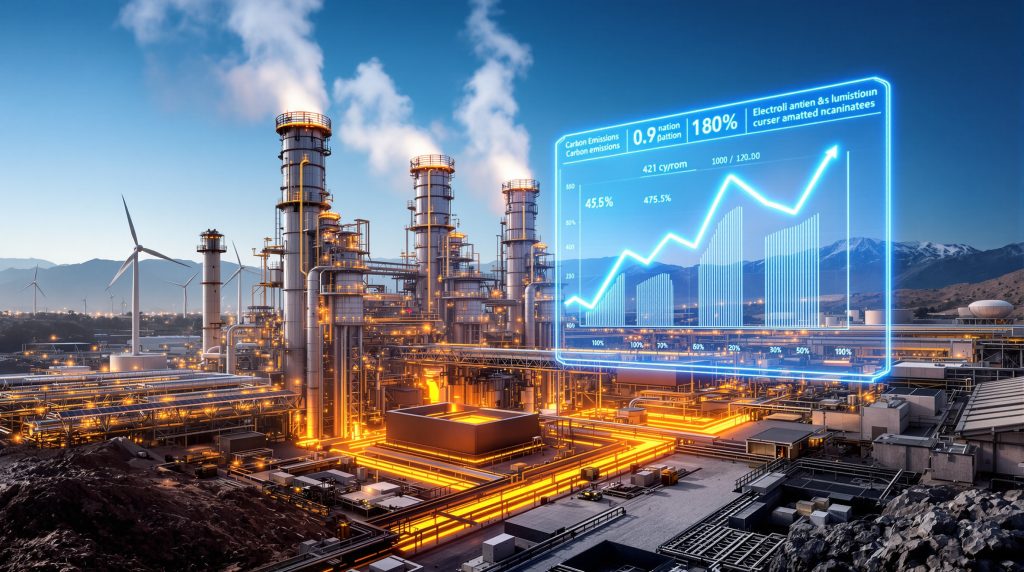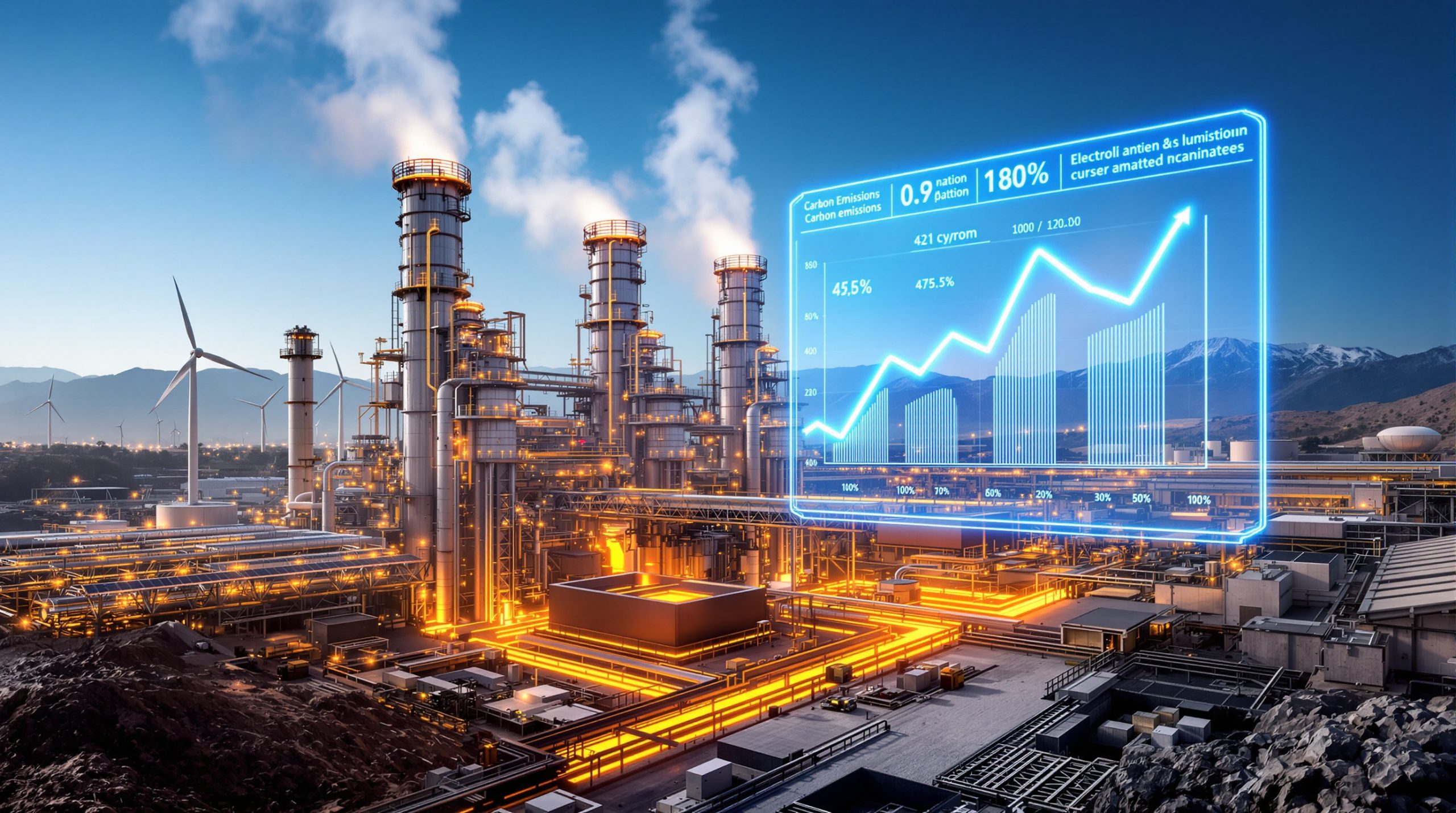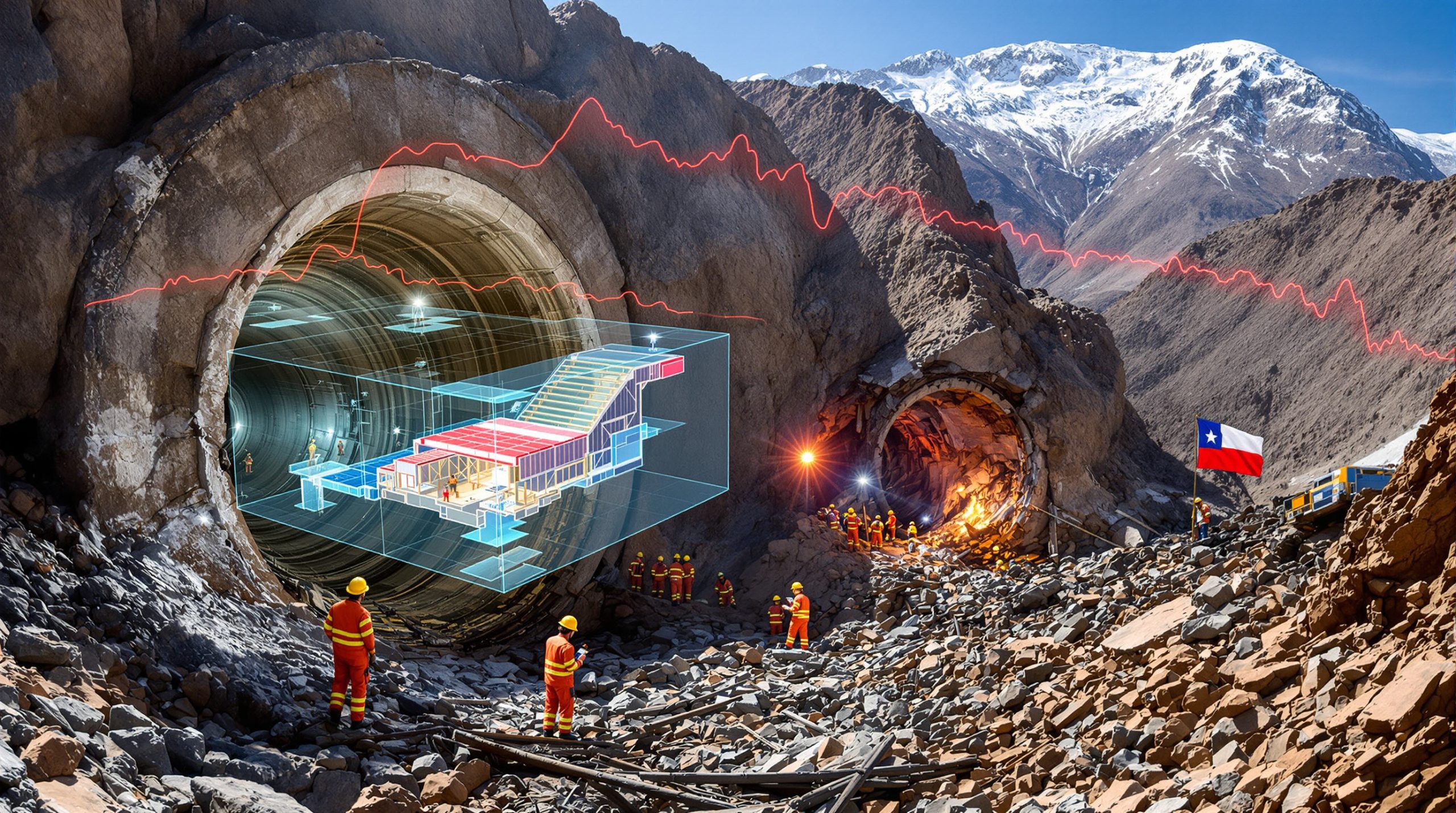Navigating the Evolving Challenges in the Global Aluminium Industry
The aluminium sector faces unprecedented challenges as global sustainability pressures, regulatory reforms, and market transformations converge. Understanding these complex threats in the aluminium industry is essential for industry stakeholders seeking to navigate an increasingly constrained operating environment while positioning for future success in a carbon-conscious world.
What Are the Most Significant Environmental Challenges Facing Aluminium Production?
Carbon-Intensive Production Methods
Primary aluminium production, particularly through the traditional Hall-Héroult electrolytic process, ranks among the most energy-intensive industrial activities globally. This process requires enormous electricity inputs, with production facilities consuming between 13-17 MWh per tonne of aluminium produced. When powered by fossil fuels, particularly coal, this translates to substantial carbon emissions.
The industry's carbon footprint varies dramatically depending on power sources. Coal-powered smelters can produce upwards of 16 tonnes of CO₂ per tonne of aluminium, while hydropower-based production might generate only 4-6 tonnes – still significant but substantially lower. With global aluminium demand projected to increase 50% by 2050, addressing these emissions has become an existential industry challenge.
Resource Extraction Impacts
Bauxite mining creates significant environmental disruption through extensive land disturbance, deforestation, and potential water contamination. Modern aluminium production requires approximately 4-5 tonnes of bauxite ore to produce a single tonne of aluminium, creating an enormous resource footprint.
Mining operations frequently impact biodiversity hotspots in tropical regions where major bauxite reserves are concentrated. In Guinea, which holds approximately one-third of global bauxite reserves, mining expansion threatens critical ecosystems. Recent environmental impact assessments have documented biodiversity losses in mining regions, with mine reclamation innovations achieving mixed results.
Water and Waste Management Issues
For every tonne of aluminium produced, approximately 1.5 tonnes of highly alkaline bauxite residue (red mud) is generated. This caustic material requires careful containment and management, with proper disposal facilities representing a significant portion of production costs.
Water usage presents another environmental challenge, with refineries typically consuming 5-7 cubic meters of fresh water per tonne of alumina produced. In water-stressed regions, this consumption creates potential conflicts with local communities and ecosystems. Advanced water treatment and closed-loop systems can reduce consumption by 30-40%, but implementation requires substantial capital investment.
How Are Regulatory Changes Reshaping the Aluminium Sector?
Evolving Carbon Pricing Mechanisms
Carbon pricing schemes are transforming the economics of aluminium production globally. The European Union's Carbon Border Adjustment Mechanism (CBAM), implemented in 2023, directly impacts aluminium imports with fees based on carbon intensity. This mechanism creates price differentials of €60-120 per tonne depending on production methods.
Analysis from metals industry publications indicates that these pricing mechanisms are creating regional competitive disparities. High-carbon producers face growing cost disadvantages in regulated markets, with potential margin erosion of 8-15% for the most carbon-intensive operations. Industry forecasts suggest these differentials will increase as carbon prices continue their upward trajectory.
Emissions Reporting Requirements
New mandatory emissions disclosure regulations are creating unprecedented transparency throughout the aluminium value chain. Producers must now document, verify, and report their carbon footprints with increasing detail and accuracy. This regulatory shift is exposing high-emission facilities to market scrutiny and creating competitive advantages for lower-carbon producers.
The International Aluminium Institute has developed a standardized emissions calculation methodology to address reporting challenges, but implementation varies across regions. Companies face growing pressure to adopt these standards as customers increasingly demand verified carbon footprint information for purchased materials.
International Policy Coordination
The global nature of aluminium production and trade necessitates coordinated policy approaches. Differing regional standards create competitive imbalances and potential for "carbon leakage" where production shifts to less regulated regions. As reported by Metals Mining Review Europe in October 2025, "Governments worldwide are implementing and tightening legislation to tackle climate change."
This regulatory patchwork creates challenges for multinational producers navigating different compliance requirements. Industry associations emphasize the need for harmonized approaches, with recent policy forums focusing on establishing common carbon accounting methods and mutually recognized certification standards.
What Economic Pressures Threaten Aluminium Industry Stability?
Rising Production Cost Structures
Transitioning to lower-carbon production methods requires substantial capital investment across the value chain. Retrofitting existing smelters with emissions reduction technologies typically increases production costs by 10-25%, creating margin pressure in an already competitive market.
According to industry analyses, implementing best-available technologies for emission reduction requires capital expenditures of $300-500 per tonne of annual production capacity. These investments, while necessary for long-term viability, create short-term economic challenges for producers already facing thin margins. As Metals Mining Review Europe notes, "Production prices frequently rise as the sector invests in cleaner technology and more sustainable practices."
Supply Chain Vulnerabilities
Recent years have exposed critical vulnerabilities in aluminium supply networks. From bauxite mining to finished products, disruptions at any stage can create cascading effects throughout the value chain. Transportation bottlenecks, particularly in ocean shipping, have led to delivery delays and price volatility.
The transition toward more sustainable production creates additional coordination challenges as suppliers at different stages implement emission-reduction measures at varying paces. Companies with vertically integrated operations demonstrate greater resilience, but face higher transition costs due to their larger operational footprint.
Energy Market Volatility
Electricity typically represents 30-40% of aluminium production costs, making the industry particularly sensitive to energy market fluctuations. Recent price spikes in European and Asian markets have forced temporary production curtailments at multiple facilities, highlighting this vulnerability.
The transition toward renewable energy solutions introduces new volatility factors related to intermittency and grid capacity. While long-term renewable power purchase agreements can provide price stability, they require sophisticated energy management strategies and often significant grid infrastructure investments.
How Is Market Competition Transforming in Response to Sustainability Pressures?
Emergence of Low-Carbon Aluminium Premiums
A differentiated market for low-carbon aluminium is developing rapidly, with documented price premiums emerging for materials produced with lower emission intensities. These premiums currently range from $40-150 per tonne depending on carbon footprint and certification standards.
This market segmentation is creating new competitive dynamics as producers invest in decarbonization to access premium segments. However, industry standards for what constitutes "low-carbon aluminium" remain in flux, with multiple certification schemes competing for market acceptance.
Vertical Integration Strategies
Leading producers are increasingly pursuing vertical integration to secure supply chains and control emissions across the value chain. This trend is accelerating consolidation in certain market segments as companies seek to optimize sustainability performance through greater operational control.
Recent industry transactions demonstrate this pattern, with major producers acquiring upstream bauxite and alumina assets to secure raw material inputs with known environmental footprints. Smaller producers without integration capabilities face growing competitive challenges as market access increasingly depends on verified sustainability credentials.
Alternative Materials Competition
Advanced composites, engineered plastics, and novel alloys increasingly compete with aluminium in key sectors like automotive and aerospace. These alternatives offer their own sustainability advantages in certain applications, creating competitive pressure for traditional aluminium products.
To maintain market position, aluminium producers are investing in product development focused on enhancing performance characteristics while maintaining sustainability advantages. Alloy innovations that increase strength-to-weight ratios can preserve aluminium's competitive position against alternatives, particularly when combined with documented environmental advantages.
What Technological Solutions Are Emerging to Address Industry Challenges?
Inert Anode Technology
Breakthrough inert anode technology represents the most promising pathway to dramatically reduce direct carbon emissions from the smelting process. By replacing traditional carbon anodes with inert materials, this innovation eliminates anode-related CO₂ emissions, potentially reducing total emissions by 60-85%.
Early commercial implementations demonstrate significant potential, though challenges remain in scaling the technology. Current estimates suggest full commercialization would require capital expenditures of $1,000-1,500 per tonne of production capacity, presenting economic hurdles despite the environmental benefits.
Renewable Energy Integration
Strategic partnerships between aluminium producers and renewable energy developers are creating new low-carbon production models. Dedicated renewable energy facilities paired with aluminium production can reduce emissions by 50-70% compared to fossil fuel-powered operations.
Recent projects in Nordic countries and the Middle East demonstrate the viability of this approach, with smelters securing long-term renewable power contracts at competitive rates. These arrangements often include innovative power purchase agreements and energy storage solutions to manage intermittency.
Circular Economy Approaches
Advanced recycling technologies are improving the viability of circular aluminium systems. Recycled aluminium requires only about 5% of the energy needed for primary production, creating significant sustainability advantages.
New sorting technologies using artificial intelligence and spectroscopy can achieve 95-99% purity in recycled streams, approaching the quality of primary production. These advances enable higher recycling rates and expand the applications for secondary aluminium, though limitations remain in certain high-specification uses. Additionally, recent developments in aluminium scrap assessments have improved market transparency and pricing mechanisms.
How Can the Aluminium Industry Transform Challenges into Opportunities?
Strategic Regulatory Engagement
Proactive engagement with regulatory development offers opportunities to shape policy frameworks that recognize industry realities. As noted by Metals Mining Review Europe, "The industry must work with policymakers to give feedback and contribute to formulating realistic and feasible carbon reduction objectives."
Companies with sophisticated government relations capabilities have demonstrated success in creating more balanced regulatory approaches. Industry-wide collaboration through trade associations amplifies these efforts, particularly when supported by credible technical data and realistic transition timelines.
Cost Management Innovation
Systematic approaches to cost management while maintaining environmental goals can create competitive advantages. Energy efficiency improvements, process optimization, and strategic sourcing can offset some decarbonization costs.
Leading producers have implemented integrated cost and carbon management systems that optimize across both dimensions simultaneously. These approaches can identify efficiency opportunities that deliver both economic and environmental benefits, such as heat recovery systems that reduce both energy consumption and costs.
Collaborative Industry Initiatives
Cross-industry partnerships and pre-competitive collaboration offer pathways to address shared challenges. Joint research initiatives, technology development consortia, and shared infrastructure investments can distribute costs and accelerate solutions.
Recent industry partnerships focused on developing breakthrough technologies demonstrate the potential of collaborative approaches. By pooling resources and expertise, these initiatives can tackle fundamental challenges beyond any single company's capabilities.
What Does the Future Hold for Aluminium in a Carbon-Constrained World?
The Path to Carbon Neutrality
The aluminium industry's roadmap to carbon neutrality requires coordinated action across multiple timeframes. Near-term efficiency improvements and renewable energy adoption can achieve 30-40% emissions reductions within existing technological frameworks.
Mid-term technology transitions and longer-term breakthrough innovations complete the pathway to full decarbonization. Industry roadmaps suggest complete carbon neutrality might be achievable by 2050, though this timeline requires accelerated investment in research and development alongside supportive policy frameworks.
Market Transformation Scenarios
The industry faces several potential future scenarios depending on the pace of decarbonization and market responses. In accelerated transition scenarios, low-carbon producers gain significant competitive advantages and market share. In slower transition scenarios, regional production differences persist longer with corresponding trade implications.
Market forecasts indicate that by 2030, low-carbon aluminium could command 40-50% of global premium market segments, with rapid growth thereafter as carbon constraints tighten. Producers positioned for this transition stand to capture significant value, while those delaying action face increasing market access challenges.
Strategic Positioning for Success
Companies that strategically position themselves for the low-carbon transition will emerge as industry leaders. This positioning requires balanced investment across multiple timeframes: immediate efficiency improvements, medium-term technology adoption, and longer-term innovation development.
Successful strategies integrate sustainability transformation with core business metrics rather than treating them as separate considerations. This integration enables more effective capital allocation decisions and creates organizational alignment around transformation objectives.
Critical Questions About Aluminium Industry Challenges
How does aluminium recycling compare to primary production in terms of environmental impact?
Recycling aluminium requires approximately 95% less energy than primary production, with corresponding reductions in carbon emissions. The carbon footprint of recycled aluminium typically ranges from 0.5-0.8 tonnes CO₂ per tonne, compared to 12-16 tonnes for coal-powered primary production.
Despite these advantages, recycling cannot meet all demand due to growth in overall aluminium usage and long product lifecycles in certain applications. Additionally, quality constraints limit the use of recycled material in some high-specification applications, though technological advances are gradually addressing these limitations.
What role does China play in global aluminium sustainability challenges?
China produces approximately 60% of global primary aluminium, largely using coal-powered electricity. This concentration creates both challenges and opportunities for industry decarbonization.
Recent Chinese policy developments, including emissions trading systems and renewable energy mandates, signal potential shifts toward lower-carbon production methods. The pace of this transition has significant implications for global aluminium markets and sustainability performance.
How do different transportation sectors influence aluminium demand and sustainability?
The automotive and aerospace sectors represent critical demand drivers for aluminium, with different sustainability implications. Light-weighting vehicles with aluminium can reduce lifetime emissions through fuel efficiency, potentially offsetting production emissions after 40,000-60,000 kilometers of vehicle use.
Aerospace applications typically have longer service lives, creating favorable lifetime carbon calculations despite higher-grade material requirements. The transition toward electric vehicles creates new opportunities for aluminium, with demand for battery enclosures and structural components offsetting potential losses in internal combustion engine components.
What financing mechanisms are emerging to support aluminium industry decarbonization?
Innovative financing approaches including green bonds, sustainability-linked loans, and transition finance are becoming increasingly available to support decarbonization investments. These instruments typically offer preferential terms based on achieving specific sustainability metrics.
The aluminium sector has seen significant growth in sustainability-linked financing in recent years, demonstrating growing capital market support for the transition. These mechanisms can reduce the cost of capital for transition investments, improving project economics and accelerating implementation. Furthermore, companies are increasingly recognizing the decarbonisation benefits beyond regulatory compliance.
Carbon Footprint Comparison Across Aluminium Production Methods
| Production Method | Carbon Emissions (tonnes CO₂/tonne Al) | Energy Requirement (MWh/tonne) | Market Share (%) | Cost Premium (%) |
|---|---|---|---|---|
| Coal-powered primary | 15-18 | 14-16 | 45 | Baseline |
| Gas-powered primary | 8-10 | 14-16 | 20 | 5-10 |
| Hydro-powered primary | 4-6 | 14-16 | 25 | 10-15 |
| Inert anode technology | 2-3 | 12-14 | <1 | 15-25 |
| Recycled aluminium | 0.5-0.8 | 0.7-0.9 | 30 | -10 to -5 |
As the aluminium industry continues navigating these complex challenges, success will depend on balancing environmental imperatives with economic realities. The sector stands at a critical juncture where strategic decisions made today will determine which players thrive in tomorrow's carbon-constrained market.
Industry participants must develop comprehensive strategies addressing regulatory compliance, technology adoption, market positioning, and stakeholder engagement. Those who view threats in the aluminium industry as a core business imperative rather than a compliance obligation will find competitive advantage in this transformed landscape.
Looking for the Next Big Mining Discovery?
Discover how major mineral findings on the ASX can lead to substantial investment returns with Discovery Alert's proprietary Discovery IQ model, which delivers real-time notifications on significant discoveries. Explore historic examples of exceptional market outcomes by visiting Discovery Alert's dedicated discoveries page and begin your 30-day free trial today to position yourself ahead of the market.




